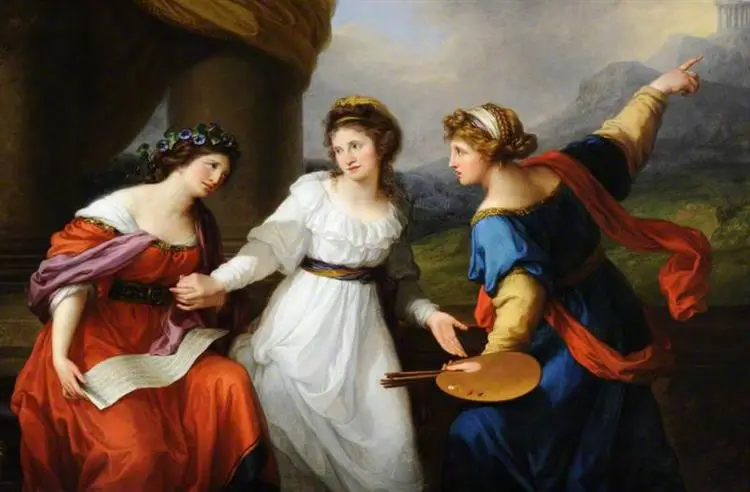If you have not heard the name, Angelica Kauffman (1741-1807) was a pioneering artist whose work transcended the boundaries of her time. Born in Switzerland and active in London, Kauffman was one of the founding members of the Royal Academy of Arts in 1768, an extraordinary achievement in an era when women were rarely recognised in the art world, and literally forbidden from attending art classes. Her paintings, renowned for their elegance and emotional depth, encompass portraits, historical scenes, and allegories that capture the complexity of human experience.
Women Empowerment Through Art
The exhibition at the Royal Academy (RA) shines a spotlight on Kauffman’s extraordinary talent and her role in the broader context of women’s empowerment in art. Throughout history, women have used art not only to express their innermost thoughts and feelings but also as a powerful tool to challenge societal norms and advocate for equality. Kauffman’s work is a vivid reminder of the artistic and intellectual contributions women have made, often against significant odds.
What I personally find empowering in her art, is not just her powerful self-portraits of how she saw herself and her status in the art community, but her paintings of other females. Unlike the trends in her period, Kaufman stayed away from painting female nudes, and focused on delivering the beauty and feelings of her female muses, and their relationship to their passions, interests and careers such as drama, comedy, and art. Kauffman also painted self-portraits of herself to communicate her narrative, her perspective on different topics, such as the elements of Art: Invention, Composition, Design and Colour; and the ability to make a career choice, such as the painting featured in the article of herself choosing between a career in music or art.
A Journey of Expression and Equality
Art has always been a medium for personal and political expression. For women, it has been a way to articulate their experiences, assert their presence, and demand their rights in a patriarchal society. Kauffman’s portraits of women, often depicted with grace and intelligence, challenge the traditional roles assigned to them and highlight their capability and strength. Her historical and allegorical paintings convey themes of virtue, wisdom, and justice, resonating with the ongoing struggle for gender equality.
Through her art, again and again, Kauffman showed that she is nothing less than an equal to the other academicians in the RA. In her self-portrait with the bust of Minerva, she painted herself in the same position as Joshua Reynolds, head of the RA, in his grand self-portrait with the bust of Michelangelo. The suggested Kauffman’s well deserved confidence in seeing herself as an equal in skill to her counterpart male master of art.
Moreover, in a letter to the Council of the Royal Academy, Kauffman protested the work of a fellow academician Nathaniel Hone, who portrayed her as a child with a background of a group of naked cavorting artists. Kauffman letter’s demanded the removal of the painting, or the withdrawal of all her paintings from the society. She described Hone as ‘an Academician who pays no respect to the sex. In response, the RA got Hone to remove the painting from the RA’s exhibition and paint over the offending scene before exhibiting in other venues.
The Legacy of Women Artists
Kauffman’s legacy is a source of inspiration for contemporary women artists who continue to use their creativity to advocate for change. The exhibition at the RA not only honors her contributions but also serves as a platform to reflect on the progress made in the realm of art and society. It underscores the importance of providing spaces where women’s voices can be heard and their talents recognised.
After all, can you believe that in 1771, Painter Johan Zoffany painted a group portrait to celebrate the founding members of the RA, showing the members gathered in their life drawing room. As women were not allowed into the drawing room at the time, Zoffany could not depict Kauffman and the other female founding member with the rest of the group. Feeling bad to leave them out of the portrait, he included them by featuring their likeness as portraits on the wall. This painful story highlights how far women have come in enforcing equality.
The Power of Art in Shaping Society
Art has the profound ability to influence societal perceptions and inspire action. Kauffman’s work, along with that of other pioneering women artists, has paved the way for a more inclusive and equitable art world. The themes explored in her paintings—such as justice, equality, and the human condition—are as relevant today as they were in her time. By engaging with her work, viewers are reminded of the enduring power of art to shape thought, inspire change, and promote equality.
Conclusion
Angelica Kauffman’s exhibition at the Royal Academy is more than a celebration of her artistic prowess; it is a tribute to the enduring legacy of women in art. It highlights the strides made in using art as a vehicle for expression and empowerment and acknowledges the ongoing journey towards equality. As we reflect on Kauffman’s contributions, we are reminded of the vital role art plays in advocating for a more just and inclusive society.

